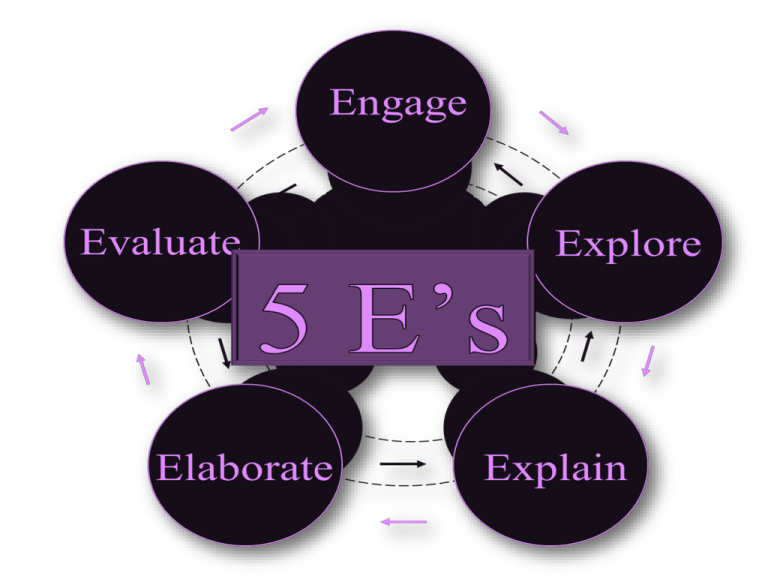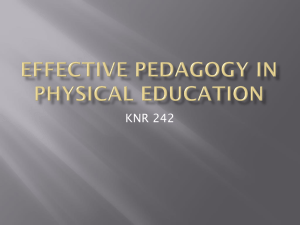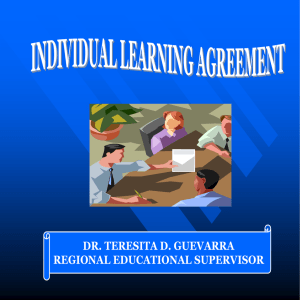The 5 Es - kvszietmysorephysics
advertisement

Attention-focusing questions Have you seen? Do you notice? Engage Measuring & Counting and Comparison Questions How many? How long? Evaluate Explore Action & ProblemSolving Questions Elaborate What happens if… Can you find a way to… Explain In how many ways? The 5 E's The 5 E's is an instructional model based on the constructivist approach to learning, which says that learners build or construct new ideas on top of their old ideas. The 5 E's can be used with students of all ages, including adults. Each of the 5 E's describes a phase of learning, and each phase begins with the letter "E": Engage, Explore, Explain, Elaborate, and Evaluate. The 5 E's allows students and teachers to experience common activities, to use and build on prior knowledge and experience, to construct meaning, and to continually assess their understanding of a concept. Constructivism is a learning strategy that draws on students' existing knowledge, beliefs, and skills. With a constructivist approach, students synthesize new understanding from prior learning and new information. The constructivist teacher sets up problems and monitors student exploration, guides student inquiry, and promotes new patterns of thinking. Working mostly with raw data, primary sources, and interactive material, constructivist teaching asks students to work with their own data and learn to direct their own explorations. Ultimately, students begin to think of learning as accumulated, evolving knowledge. Constructivism The philosophy about learning, that proposes learners need to build their own understanding of new ideas, has been labeled constructivism. Much has been researched and written by many eminent leaders in the fields of learning theory and cognition. Scholars such as Jean Piaget, Eleanor Duckworth, George Hein, and Howard Gardener have explored these ideas in-depth. The Biological Science Curriculum Study (BSCS), a team whose Principal Investigator is Roger Bybee developed an instructional model for constructivism, called the "Five Es“. The 5 E Learning Cycle Model Engagement *Object, event or question used to engage students. *Connections facilitated between what students know and can do. Exploration *Objects and phenomena are explored. *Hands-on activities, with guidance. Explanation *Students explain their understanding of concepts and processes. *New concepts and skills are introduced as conceptual clarity and cohesion are sought. Elaboration *Activities allow students to apply concepts in contexts, and build on or extend understanding and skill. Evaluation *Students assess their knowledge, skills and abilities. Activities permit evaluation of student development and lesson effectiveness. Adapted from Bybee, R.W. et al. (1989). Questions for Consideration for Each Phase 1. Engagement • The engagement phase of the 5-E model is intended to provide a focus for the lesson and to allow the teacher to probe students’ initial conceptions. • What do students already know about the concept? • What do they want to know? • What will they explore? 2. Exploration • What is the precise concept that students will explore? • What activities must the children do to become familiar with the concept? • What kinds of observations and records should the children keep? • What kinds of instructions will the children need? How can you give the instructions without telling the concept? 3. Explanation • What kinds of information or findings should the children talk about? • How can you help students summarize their findings? • How can you guide the students and refrain from telling them what they should have found, even if their understanding is incomplete? • What concept “labels” should the children discover? • Why is the concept important? 4. Expansion • How can you connect with children's prior experiences? • How does the concept relate to the science program goals? • What questions can be used to encourage discovery of the concept's importance? • What new experiences will help to apply or expand the concept? • What is the next concept related to the present one? 5. Evaluation • What are the appropriate learning outcomes you should expect? • What types of hands-on evaluation techniques can the children do to demonstrate the basic process skills? • What techniques are appropriate for children to demonstrate the integrated process skills? • How can pictures help children to demonstrate how well they can think through problems? • What types of questions will help children to reflect on what they have discovered? Engage In the stage Engage, the students first encounter and identify the instructional task. Here they make connections between past and present learning experiences, lay the organizational ground work for the activities ahead and stimulate their involvement in the anticipation of these activities. Asking a question, defining a problem, showing a surprising event and acting out a problematic situation are all ways to engage the students and focus them on the instructional tasks. If we were to make an analogy to the world of marketing a product, at first we need to grab the customer's attention. We won't have their attention unless they have a need to buy the product. They may be unaware of a need, and in this case we are motivated to create a need. Explore In the Exploration stage the students have the opportunity to get directly involved with phenomena and materials. Involving themselves in these activities they develop a grounding of experience with the phenomenon. As they work together in teams, students build a base of common experience which assists them in the process of sharing and communicating. The teacher acts as a facilitator, providing materials and guiding the students' focus. The students' inquiry process drives the instruction during an exploration. Explain The third stage, Explain, is the point at which the learner begins to put the abstract experience through which she/he has gone /into a communicable form. Language provides motivation for sequencing events into a logical format. Communication occurs between peers, the facilitator, or within the learner himself. Working in groups, learners support each other's understanding as they articulate their observations, ideas, questions and hypotheses. Language provides a tool of communicable labels. These labels, applied to elements of abstract exploration, give the learner a means of sharing these explorations. Explanations from the facilitator can provide names that correspond to historical and standard language, for student findings and events. For example a child, through her exploration, may state they have noticed that a magnet has a tendency to "stick" to a certain metallic object. The facilitator, in her discussion with the child, might at this stage introduce terminology referring to "an attracting force". Introducing labels, after the child has had a direct experience, is far more meaningful than before that experience. The experiential base she has built offers the student an attachment place for the label. Common language enhances the sharing and communication between facilitator and students. The facilitator can determine levels of understanding and possible misconceptions. Created works such as writing, drawing, video, or tape recordings are communications that provide recorded evidence of the learner's development, progress and growth. Explain Elaborate In stage four, Elaborate, the students expand on the concepts they have learned, make connections to other related concepts, and apply their understandings to the world around them. For example, while exploring light phenomena, a learner constructs an understanding of the path light travels through space. Examining a lamp post, she may notice that the shadow of the post changes its location as the day grows later. This observation can lead to further inquiry as to possible connections between the shadow's changing location and the changes in direction of the light source, the Sun. Applications to real world events, such as where to plant flowers so that they receive sunlight most of the day, or how to prop up a beach umbrella for shade from the Sun, are both extensions and applications of the concept that light travels in a straight path. These connections often lead to further inquiry and new understandings. Evaluate Evaluate, the fifth "E", is an on-going diagnostic process that allows the teacher to determine if the learner has attained understanding of concepts and knowledge. Evaluation and assessment can occur at all points along the continuum of the instructional process. Some of the tools that assist in this diagnostic process are: rubrics (quantified and prioritized outcome expectations) determined hand-inhand with the lesson design, teacher observation structured by checklists, student interviews, portfolios designed with specific purposes, project and problem-based learning products, and embedded assessments. Concrete evidence of the learning proceed is most valuable in communications between students, teachers, parents and administrators. Displays of attainment and progress enhance understanding for all parties involved in the educational process, and can become jumping off points for further enrichment of the students' education. These evidences of learning serve to guide the teacher in further lesson planning and may signal the need for modification and change of direction. For example, if a teacher perceives clear evidence of misconception, then he/she can revisit the concept to enhance clearer understanding. If the students show profound interest in a branching direction of inquiry, the teacher can consider refocusing the investigation to take advantage of this high level of interest. BLOOMS Levels of Thinking Students Teachers Creating The learner creates new ideas and information using what has been previously learned. The teacher plans and implements new approaches and improvements based on previous experience or new information. Evaluating The learner makes decisions based on in-depth reflection, criticism and assessment. The teacher reflects upon data. Interprets strengths/weaknesses and plans improvements. Analyzing The learner breaks learned information into its parts to best understand that information. The teacher seeks feedback on their own and their student’s performance. Collects data. Applying The learner makes use of information in a context different from the one in which it was learned. The teacher develops and applies effective programs and strategies to ‘Teach’ the discipline. Understanding The learner grasps the meaning of information by interpreting and translating what has been learned. The teacher has an overview of the discipline, effective learning approaches and links to the whole curriculum. Remembering The learner is able to recall, restate and remember learned information. The teacher is aware of the basic content and teaching methodologies in a discipline. *Blooms taxonomy is familiar to most teachers and is often used as a structure to plan learning programs and assessment tasks. The column here for teachers is based only on armchair thinking but it holds up reasonably well. As with students the thought processes for teachers become more sophisticated up the table. Although it could be argued that many teachers, particularly those new to the game or outside their “subject” area, find themselves having to jump straight into the creating level. *An interesting question is whether teachers actually understand and believe in a construction like Blooms taxonomy as a framework for “higher order thinking”. If they do they may also see that there are parallels with their own learning and hence value the levels of analysis, evaluation and creating as superior (albeit harder) than the lower levels. *Now let’s look at the 5 E’s. This instructional model has been around for many years and is currently the basis of some project work being undertaken by DEECD to assist schools with curriculum implementation. 5 E’s Evaluate: Planning for student learning This phase of the 5 E's encourages learners to assess their understanding and abilities and lets teachers evaluate students' understanding of key concepts and skill development. Planning for teacher learning Teachers evaluate the effectiveness of their programs and their performance through the lense of student achievement. Elaborate: This phase of the 5 E's extends students' conceptual understanding and allows them to practice skills and behaviours. Through new experiences, the learners develop deeper and broader understanding of major concepts, obtain more information about areas of interest, and refine their skills. Teachers reflect upon their practice and hone their skills. Teachers increase the depth of their understanding of both their disciplines and teaching methodologies. Explain: This phase of the 5 E's helps students explain the Teachers implement programs, try things out. concepts they have been exploring. They have They explain to students. They demonstrate opportunities to verbalize their conceptual understanding new skills and behaviours. or to demonstrate new skills or behaviors. This phase also provides opportunities for teachers to introduce formal terms, definitions, and explanations for concepts, processes, skills, or behaviors. Explore: This phase of the 5 E's provides students with a common base of experiences. They identify and develop concepts, processes, and skills. During this phase, students actively explore their environment or manipulate materials. Teachers explore resources available to them, text books, curriculum standards, online resources. They work in teams learning from each other. They plan programs and lessons Engage: This phase of the 5 E's starts the process. An "engage" activity should do the following: 1. Make connections between past and present learning experiences 2. Anticipate activities and focus students' thinking on the learning outcomes of current activities. Students should become mentally engaged in the concept, process, or skill to be learned. Teacher’s become engaged through personal interest, planned or accidental learning. Teachers are often coerced to be engaged through DEECD and school level requirements e.g. VELS, assessment, teacher shortage, school initiatives. Engage - students encounter the material, define their questions, lay the groundwork for their tasks, make connections from new to known, identify relevance Explore - students directly involved with material, inquiry drives the process, teamwork is used to share and build knowledge base Explain - learner explains the discoveries, processes, and concepts, that have been learned through written, verbal or creative projects. Instructor supplies resources, feedback, vocabulary, and clarifies misconceptions Elaborate - learners expand on their knowledge, connect it to similar concepts, apply it to other situations - can lead to new inquiry Evaluate - on-going process by both instructor and learner to check for understanding. Rubrics, checklists, teacher interviews, portfolios, problem-based learning outputs, and embedded assessments. Results are used to evaluate and modify further instructional needs. 5 - E Lesson Plan Template The lesson title: _________________________________________________________ Subject: Concepts to be attained: __________________________________________________ Concepts that are important to expansion: ____________________________________ Materials needed: • For explorations • For expansions 1. Engagement What is the focus of the lesson? 2. Exploration Which skills will be used? What will students do? 3. Explanation What is the main idea (concept) ? How will the main idea (concept) be constructed? 4. Expansion Which process skills will be used? How will the idea be expanded? 5. Evaluation How will the students show what they have learned?








